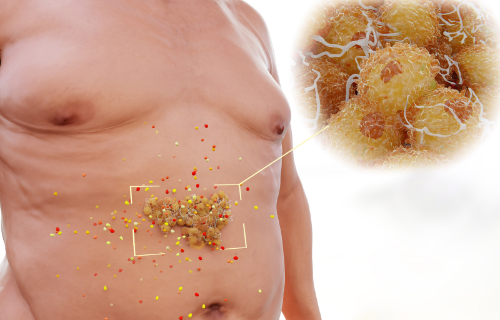Difference Between Parietal Peritoneum and Visceral Peritoneum

Introduction
The peritoneal cavity occurs inside the abdominal cavity and continues on where it eventually becomes the pelvic cavity. It has no organs inside but contains a thin film of peritoneal fluid. This fluid provides a source of lubrication to the peritoneal surfaces, allowing the membranes to move over each other without causing too much friction.
The peritoneum is defined as a continuous membrane which functions to line the abdominal cavity and therefore hold and protect the abdominal organs (also known as the abdominal viscera).
Although it acts to protect and support the viscera, it also allows for pathways that blood vessels and lymph can travel. The peritoneum consists of two distinct layers. These layers are continuous with each other and include the parietal peritoneum and the visceral peritoneum. Both layers of the peritoneum are structurally the same and comprise simple squamous epithelial cells (also called mesothelium).
This article takes a closer look at these two layers, identifying the differences that occur between them.

Definition
The parietal peritoneum is the membrane which lines the internal surface of the abdominopelvic (between the abdomen and pelvis) wall and the diaphragm. It is formed from somatic mesoderm during embryonic stages.
The visceral peritoneum is the membrane which folds back (or turns inside out to cover most of the abdominal organs. It is also formed from somatic mesoderm during embryonic stages.
Blood and Nerve Supply
The parietal peritoneum receives its blood and nerve supply from the same nerve to which it is connected along the area of the abdominal wall it is lining. The parietal peritoneum is sensitive to temperature, wounds, pressure and pain.
The visceral peritoneum receives its blood and nerve supply from the same autonomic nerve to which the organ it is covering is connected. In terms of nerves, the visceral peritoneum is less sensitive than the parietal peritoneum and is sensitive to being stretched or exposed to certain chemicals.
Pain Presentation
Pain from the parietal peritoneum is generally well localized except when it occurs on the inside middle part of the diaphragm. The nerve origin changes presentation when it occurs here and, in such cases, it is often referred (pain presents elsewhere) to skin pain receptors that are found over the shoulder.
When pain occurs from the parietal peritoneum it starts off as a dull pain which quickly progresses into a very specific area (localized), where it remains and becomes very severe.
Pain that comes from the visceral peritoneum presents itself in areas of skin which are supplied by the same nervous sensory segments as the nerve fibres going into the abdominal organs. When pain comes from the visceral peritoneum, it is often a dull type of pain and is not easily located. It presents as a general area which is in pain.
Comparison table for parietal peritoneum and visceral peritoneum

Summary
The peritoneum is an important structure within the abdominal cavity. It holds key functions which aid in the supporting and suspension of abdominal the organs, keeping them in their proper place within the abdominopelvic cavity. The peritoneum also allows organs to move around which being protected, also protecting the nerve and blood supply to specific organs (for example, it protects arteries between the aorta to the intestines).
The two layers the make up the peritoneum, namely the parietal peritoneum and the visceral peritoneum, are both unique in function. The parietal peritoneum primarily lines the inside of the area between the abdomen and the pelvis, as well as the diaphragm. The visceral peritoneum, on the other hand, lines most of the abdominal organs inside the abdominal cavity. This is done by the membrane folding itself in a particular manner.
The parietal peritoneum is much more sensitive than the visceral peritoneum. Most likely because of its position being less deep. Where the parietal peritoneum is sensitive to temperature, wounds, pressure and pain; the visceral peritoneum is only sensitive to stretch and to specific chemical exposures. Pain that occurs in the parietal peritoneum is more site specific, where it lingers and becomes increasingly severe. Pain from the visceral peritoneal layer is more of a dull feeling pain and it is generally challenging to localize.
Although both membranous layers are part of the greater peritoneum, each layer has specific functions and importance. The layer glide over each other and it is important to be aware of the specific differences to understand what pain may mean, or what diagnosis are made by medical physicians.
FAQ
What is the visceral peritoneum?
The visceral peritoneum is known as the serous membrane that functions to cover the external (or outer most) surfaces of most of the abdominal organs, including the long intestines.
Is visceral peritoneum continuous with parietal peritoneum?
Yes. The visceral peritoneum is continuous with the parietal peritoneum.
What is the difference between retroperitoneum and peritoneum?
Retroperitoneal means that an organ is positioned between the body wall and the peritoneum (in other words, positioned behind the peritoneal cavity). Primary retroperitoneal organs indicate organs that never occurred inside the peritoneal cavity. Secondarily retroperitoneal organs refer to organs that started as intraperitoneal organs during initial development stages, but they end up as retroperitoneal organs once they have been fully developed. In summary, retroperitoneum is just a way to classify an organ in relation to the peritoneum.
What is the difference between mesentery and peritoneum?
A mesentery is the definition give to a double layer of peritoneum that occurs as a result of being turned inside out by an organ and includes a continuity of the visceral and parietal peritoneum. This is not a bad function or state or peritoneum, for example, a mesentery is useful to connect an intraperitoneal organ to the body wall.
- Difference Between a Cochlear Implant and Normal Hearing - October 4, 2022
- Difference Between Obstructive and Restrictive Spirometry - September 11, 2022
- The Difference Between White Box and Black Box Testing - September 11, 2022
Search DifferenceBetween.net :
Leave a Response
References :
[0]Drake, Richard., Vogl, Wayne. & Mitchell, Adam. “Gray’s Anatomy for Students”. 4th Edition, 2019, pp: 1180.
[1]Kalra, Arjun. & Wehrle, Chase. “Anatomy, Abdomen and Pelvis, Peritoneum”. StatPearls, https://www.statpearls.com/articlelibrary/viewarticle/32341/
[2]Moore, Kieth., Agur, Anne. & Dalley, Arthur. “Clinically Oriented Anatomy”. 2014. Print.
